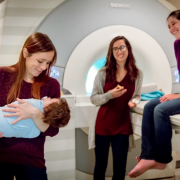The challenges of tackling this question are so daunting that few have tried. But Heather Kosakowski, a PhD candidate at MIT, is determined to find answers.
It‘s Ursula’s third time in the functional MRI machine. Heather Kosakowski, a PhD student in cognitive neuroscience, is hoping to get just two precious minutes of data from her session. Even though Ursula has been booked to have her brain scanned for two hours, it’s far from a sure thing. Her first two sessions, also booked for two hours each, yielded only eight minutes of usable material combined.
The task verges on the impossible. Kosakowski needs Ursula to stay both awake, watching projected images of faces and scenes, and very still, ideally for seconds or even minutes at a time. Every twitch and wiggle blurs the MRI’s scan, obscuring the image and rendering it useless. But Ursula tends to squirm and then, inevitably, fall asleep—exactly what you would expect from a six-month-old baby.
Scanning infants’ brains while they’re awake is incredibly difficult and time consuming, and there’s always a risk that a session will produce no data at all. A motivated adult is capable of staying perfectly still for two hours, yielding brain images that read like an open book. Ursula’s sessions produce something more akin to a book that’s been torn up and thrown in a river. Kosakowski, who is jointly advised by cognitive neuroscience professors Nancy Kanwisher ’80, PhD ’86, and Rebecca Saxe, PhD ’03, needs to carefully fish out the usable sections and stitch them together before she can read the story they reveal.
“Heather is probably the most skilled person alive today at getting high-quality functional MRI data from human infants,” says Kanwisher, the Walter A. Rosenblith Professor of Cognitive Neuroscience.
If Kosakowski doesn’t get the two minutes of still brain images she needs, it’s possible Ursula’s two previous visits will have been for nothing. But if she can get a clear fMRI reading, she will be one step closer to answering one of the most profound questions in modern neuroscience: What are the physical underpinnings of the human mind?
A far-off dream
Kosakowski is no stranger to overcoming obstacles. Her childhood was characterized by the sort of instability that made any kind of higher education feel unattainable. Her father was in the military, so her family moved around a lot. Then her parents divorced, and the difficulties multiplied. When she was about seven, she and her mother moved into a homeless shelter, and at 11, Kosakowski was put into foster care in Western Massachusetts. “Having a bachelor’s degree was always my dream,” she says, but she calls her first attempt at college a “dismal failure.”
“I dropped out, I was homeless and had no job, and then I totaled my car and I was like, what am I going to do with my life?” she recalls. She decided to enter the Marine Corps but hoped she might someday get a second shot at college.
After several years in the military, Kosakowski left the Marines and returned to Massachusetts, enrolling part time at Massachusetts Bay Community College. Maybe, she thought, a bachelor’s degree wasn’t so far out of reach after all. She set her sights on Smith College, where she was admitted. But around the time she received that piece of news, she also got another: she was pregnant.
Kosakowski didn’t go to college anywhere that fall, but her eagerness to learn persisted. Her natural curiosity found an outlet in her baby, Hannah, who was born that October. She watched Hannah experience grass for the first time in the spring, delighting at how she reacted to this strange new material covering the ground. As Hannah explored her environment, Kosakowski kept wondering what things looked like from her perspective. What was she experiencing? How was she making sense of the world around her?
When Hannah was two, Kosakowski got a job at a nonprofit that was working to speed up research on multiple sclerosis, giving her the opportunity to attend a neuroscience conference. “After that I was kind of hooked,” she says. “I was like, okay, the thing I really want to be doing is research, and in order to do research I need a degree. I have to go back to school.”
Kosakowski was accepted to Wellesley College—a school she had written off years before because it was so competitive. She became fascinated with neuroscience, peppering her professors with questions until one said, “Heather, some of the questions you ask, nobody knows the answer. You should get a PhD.”
“I just kept scanning”
Just as Kosakowski graduated from Wellesley, Saxe was looking for a manager for her lab, which happened to be one of the only labs in the world studying babies in MRIs while they are awake—and consequently one of the only ones that could answer Kosakowski’s questions about the nature of infant cognition. She applied for the position and got it.
When her foster sister had a baby, Kosakowski went to Saxe and asked if she could learn how to use the fMRI to scan the infant’s brain. “I think she thought I’d just scan my niece and be done with it,” Kosakowski says. “But I just kept scanning, and she never told me to stop.” Saxe, impressed with Kosakowski’s work and determination, agreed to take her on as a graduate student. In 2017, she left her job as lab manager and began her first semester as a PhD candidate at MIT.
Read the whole story on Technology Review's website using the link below.

